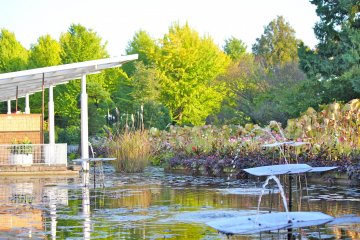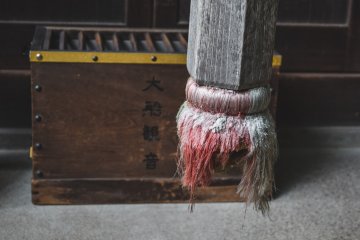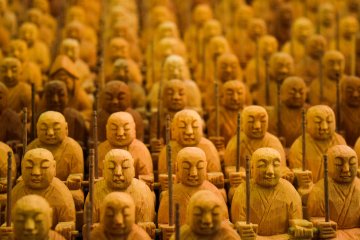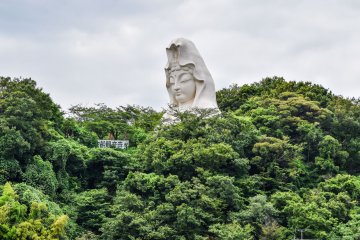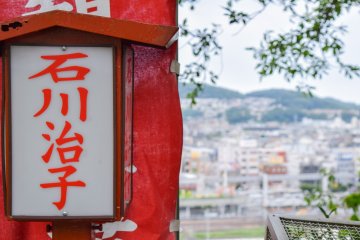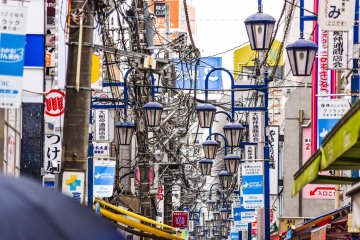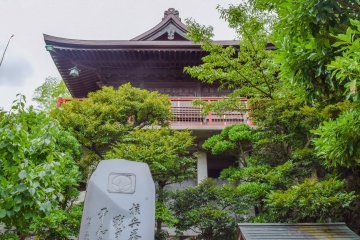The Giant White Kannon Statue
Ofuna Kannon sits a 5-minute walk to the west of Ofuna Station in Kamakura City, Kanagawa Prefecture. At a commanding 25 metres in height, this impressive "goddess of mercy of the white robe" sculpture saw completion in 1960, despite initial construction having begun in 1929. WWII put various attempts to recommence on hold but it was certainly worth the wait. The compelling stone and concrete bust watches over the area, affording protection to those who come to pray.

Construction of the Kannon
One of the loveliest things about the construction of the Kannon is the materials used. Forgoing pump trucks, all the concrete used was poured by hand. Furthermore, said concrete surrounds rocks taken from the very sites where atomic bombs were dropped on both Hiroshima and Nagasaki, offering permanent and practical commemoration to those who suffered amid one of humankind's darkest times. A serene shade of white is painted on the surface.
Inside the Kannon
Up the stairs, at the rear of the statue, is where you'll find the entrance to what is beneath that surface and stone. Here visitors will find a small museum and an inner shrine. The museum is small but feels a world away from the concrete and chaos of the cityscape which surrounds the temple. The interior is replete with creations in ode to the souls of the dead and prayers for world peace, particularly where war and nuclear weapons are concerned, remembering the origins of those stones upon which the statue was built. Many of these creations are Buddha statues, the highlight being a truly estimable "thousand Buddha" wood carving. Also inside, you'll see a booklet in which you can pen your own personal message or prayer to the Kannon.

Looking Around the Temple Grounds
There are other alluring but subtle features of the temple if you give yourself time to look around. Those in search of love, or perhaps those who have found love but hope to keep it, may want to pay a visit to the matchmaking tree, the name of which is self-explanatory. Jikodo Hall hosts Zen meditation sessions, prayer services and memorials. The Sho-Kannon Ritsuzo, a Kannon statue carved from a single piece of wood, calls the hall home and is only displayed to the public on the first three days of each new year. It is also during this new year period when visitors to the Kannon are permitted to ring the temple's Daibonsho Bell to say goodbye to the year that was.

I haven't yet mentioned some of the more important parts of the temple grounds, including the Sanmon Gate, the only remaining of three original gates, hence the name "San-mon." The kanji has since been changed from "three" to "mountain" maintaining phonetics whilst updating relevance; mountains are a dominating part of Japan's landscape and, on a good day, you can see part of Mount Fuji from the temple grounds.
Of course, one of the more significant parts of the Ofuna Kannon's grounds is the Shoshin-kaku Hall. This is both the main temple hall and the office. It was built as a facility where monks can reflect upon the good and evil inside themselves, by examining their thoughts and actions based on the teachings and examples of predecessors. Depending upon the time of year you visit, in the area surrounding the Shoshin-kaku Hall, you may also find things like red shiso or plums being dried out in the sun to make umeboshi (salty pickled plums)

Peace, Love and Events
The temple hosts various events monthly and yearly. Kannon Day takes place on the 18th of each month (except for May) and affords the chance to learn Zen meditation through sutra chanting, singing Buddhist hymns, prayer and even working in the gardens. Each September is the Yume Kannon Festival which sees visitors sing, dance and immerse in a traditional Japanese atmosphere. The aim of the above, regardless of whether you're Japanese or not, is to come together and celebrate love, diversity and peace in the name of Kannon.
Regardless of one's specific beliefs or religious affiliation, Ofuna Kannon exists as both a place of peaceful tranquillity hidden on the outskirts of the world's largest metropolis and simply a great place to take a camera. It's also another sakura season spot. The bonus is that it is almost literally a stone's throw from Ofuna Station.





